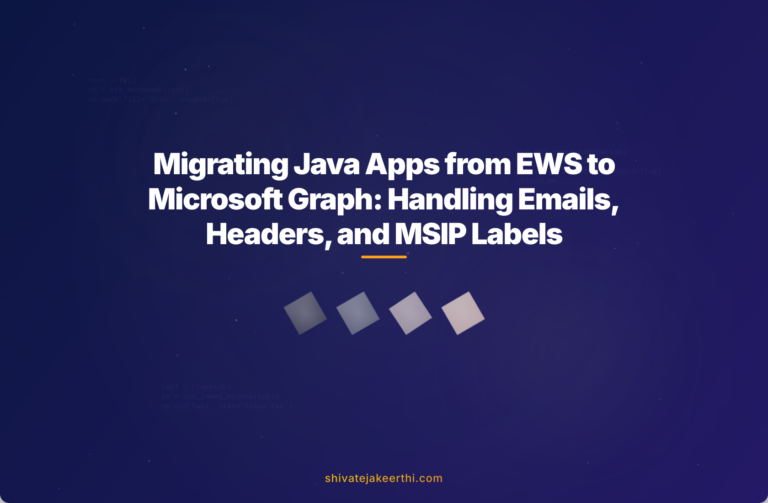Migrating from Exchange Web Services (EWS) to Microsoft Graph API can be challenging, especially when it involves tasks like sending emails using MIME format in Java applications. Microsoft Graph API is becoming the preferred standard for interacting with Microsoft 365 services, pushing developers previously using EWS toward the newer Graph API. A common question developers ask is how to handle advanced email scenarios, particularly when adding custom headers and MSIP labels that were straightforward in EWS but pose unique challenges with Graph API.
Adding MSIP Labels in Email Headers
Organizations frequently use Microsoft Information Protection (MSIP) labels to ensure sensitive information is appropriately classified and protected within Exchange-managed services. MSIP labels help enforce compliance standards and data loss prevention policies by embedding classification information directly into email headers.
Implementing MSIP labels in Exchange typically involves adding a header (e.g., “msip_labels”) directly to emails. With EWS, developers easily added these labeled headers directly to messages in standard MIME format. However, Graph API brings an important caveat: it currently restricts custom headers, allowing only those starting with “X-” or “x-“. This means previously used headers like “msip_labels” can’t be directly inserted using standard Graph API methods.
Current Implementation with Graph API
When sending emails using Graph API, one typical workflow equals creating a draft message from request parameters, adding additional data or headers as needed, and then sending the message using its unique identifier (messageId). Here’s how you might generally approach this in Java when using Microsoft Graph SDK:
- Create a new email draft by specifying basic attributes like recipients, subject, and body.
- Save this draft in the user’s Outlook drafts folder for further editing or header extraction.
- Once you complete modifications, use the draft’s unique messageId to call the primary send method.
Here is a simplified Java snippet demonstrating creating and sending an email using Graph SDK:
// Initialize your Graph client
Message message = new Message();
message.subject = "Example Mail Subject";
message.body = new ItemBody();
message.body.contentType = BodyType.HTML;
message.body.content = "Your email content here";
// Set recipient details
Recipient recipient = new Recipient();
EmailAddress emailAddress = new EmailAddress();
emailAddress.address = "recipient@example.com";
recipient.emailAddress = emailAddress;
message.toRecipients = List.of(recipient);
// Save as draft to retrieve messageId
Message savedMessage = graphClient
.users("user-id")
.messages()
.buildRequest()
.post(message);
// Send email using saved draft messageId
graphClient.users("user-id")
.messages(savedMessage.id)
.send()
.buildRequest()
.post();
Although straightforward, this method limits your header customization due to Graph API restrictions mentioned earlier.
Challenges Faced in Adding Headers with Graph API
A significant limitation developers run into is Graph API’s restriction for custom header names. Unlike EWS, which allowed defining virtually any custom email header, Graph API explicitly restricts you to headers prefixed with “X-” or “x-“. This can be challenging for emails requiring specific headers to comply fully with organizational compliance policies, like MSIP labeling.
Microsoft’s official Graph API documentation briefly touches on sending raw MIME-formatted messages, suggesting the possibility to include other headers beyond X- headers. However, MIME messages themselves need to be constructed manually or via third-party tools, adding complexity to the implementation.
Exploring Options with Microsoft Graph API v6.x and Java 17
Given recent improvements and releases like Java 17 and Microsoft Graph API v6.x, developers often inquire if these upgrades offer built-in or simplified ways to send MIME-formatted emails directly. Unfortunately, direct MIME message construction is currently not provided out-of-the-box in Graph SDK for Java. As a developer, you’ll likely still rely on manual construction or custom RESTful calls for MIME-based emails.
For constructing MIME content, many Java developers either manually build the MIME string or rely on versatile, lightweight libraries. Since Graph SDK emphasizes modern API architecture, MIME support typically requires custom code development, REST API calls, or third-party libraries.
Utilizing Libraries for MIME Creation and Conversion
For MIME email handling, third-party libraries such as Jakarta Mail (formerly JavaMail) are often useful. Jakarta Mail simplifies creating comprehensive MIME messages, managing complex headers, multipart bodies, attachments, and embedded content effortlessly. After creating the message using Jakarta Mail or similar libraries, you convert the resulting email message into a MIME string before making API requests to Microsoft Graph.
Here’s how a MIME message creation might look using Jakarta Mail in Java:
Properties props = new Properties();
Session session = Session.getInstance(props);
MimeMessage mimeMessage = new MimeMessage(session);
mimeMessage.setFrom(new InternetAddress("sender@example.com"));
mimeMessage.setRecipients(Message.RecipientType.TO,
InternetAddress.parse("recipient@example.com"));
mimeMessage.setSubject("Email Subject");
mimeMessage.setText("Hello, this is example MIME text.", "utf-8", "html");
// Add your custom header
mimeMessage.setHeader("msip_labels", "Confidential");
// Convert MIME message to a string
ByteArrayOutputStream outputStream = new ByteArrayOutputStream();
mimeMessage.writeTo(outputStream);
String mimeContent = outputStream.toString(StandardCharsets.UTF_8);
You can then pass this MIME string in your Graph API request payload using RESTClient or other HTTP client libraries like Apache HttpClient or OkHttp.
Sending MIME content via raw HTTP REST request example with Java using Apache HttpClient:
HttpPost request = new HttpPost("https://graph.microsoft.com/v1.0/users/{user-id}/sendMail");
request.setHeader("Authorization", "Bearer ACCESS_TOKEN");
request.setHeader("Content-Type", "text/plain");
StringEntity entity = new StringEntity(mimeContent);
request.setEntity(entity);
try (CloseableHttpResponse response = httpClient.execute(request)) {
int status = response.getStatusLine().getStatusCode();
if (status != 202) {
// handle error
}
}
If your team also deals with JavaScript environments, this example of using JavaScript libraries for MIME might offer valuable context as well.
Navigating Your Migration Successfully
Migrating your email sending functionality from EWS to Microsoft Graph API can initially feel tricky, especially with MIME messages and MSIP labels. To summarize, here are essential points you’ll need to consider clearly:
- Built-in header restrictions in Graph API.
- Custom MIME messages may require third-party tools like Jakarta Mail or manual construction methods.
- Manual REST API calls could be necessary for MIME support due to limited built-in Java Graph SDK functionality.
The landscape continuously evolves, with Microsoft actively enhancing Graph API’s capabilities. Keeping an eye on updates through Microsoft Graph’s official documentation and community discussions on platforms like Stack Overflow can consistently guide you toward streamlined solutions.
Have you explored additional methods or libraries for MIME handling with Microsoft Graph API? Share your approach and let others benefit from your experience!



0 Comments